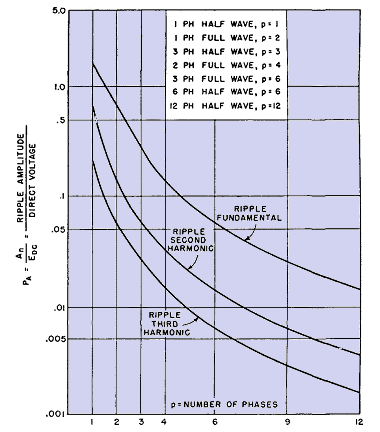| Electronic Transformers and Circuits is a free introductory textbook on transformers and related circuits. See the editorial for more information.... |

|

Home  Rectifier Performance Rectifier Performance  Polyphase Rectifiers Polyphase Rectifiers |
||||||||
| See also: Single-Phase Rectifiers, Rectifiers with Reactor-Input Filters, Rectifiers with Capacitor-Input Filters, Polyphase Transformers | ||||||||






|
||||||||
Polyphase Rectifiers
The effect of rectifying more than one phase is to superpose more voltages of the same peak value but in different time relation to each other. Figures 82 (a) and (b) give a comparative picture of the rectified output voltage for three-phase half-wave and full-wave rectifiers.
Rectifiers with p = 3 or 6 are derived from three-phase supply lines, and, by special connections, rectifiers with p = 9, 12, or more are obtained. The frequency of any ripple harmonic is mp, where m is the order of the harmonic. Ripple voltage for any of these rectifiers can be found by the Fourier relation:
where An = amplitude of nth ripple harmonic The voltage peak is chosen as t = 0 to obtain a symmetrical function f(t) and eliminate a second set of harmonic terms like those in equation 45, but with sin nωt under the integral. Ripple amplitude is given in Fig. 83 for the ripple fundamental, and second and third harmonics with reactor-input filters. In this curve, the ratio PA of ripple amplitude to direct output voltage is plotted against the number of phases p. It should be noted that PA diminishes by a considerable amount for the second and third harmonics. In general, if a filter effectively reduces the percentage of fundamental ripple across the load, the harmonics may be considered negligibly small.
|
||||||||
Home  Rectifier Performance Rectifier Performance  Polyphase Rectifiers Polyphase Rectifiers |
||||||||
Last Update: 2011-01-24




